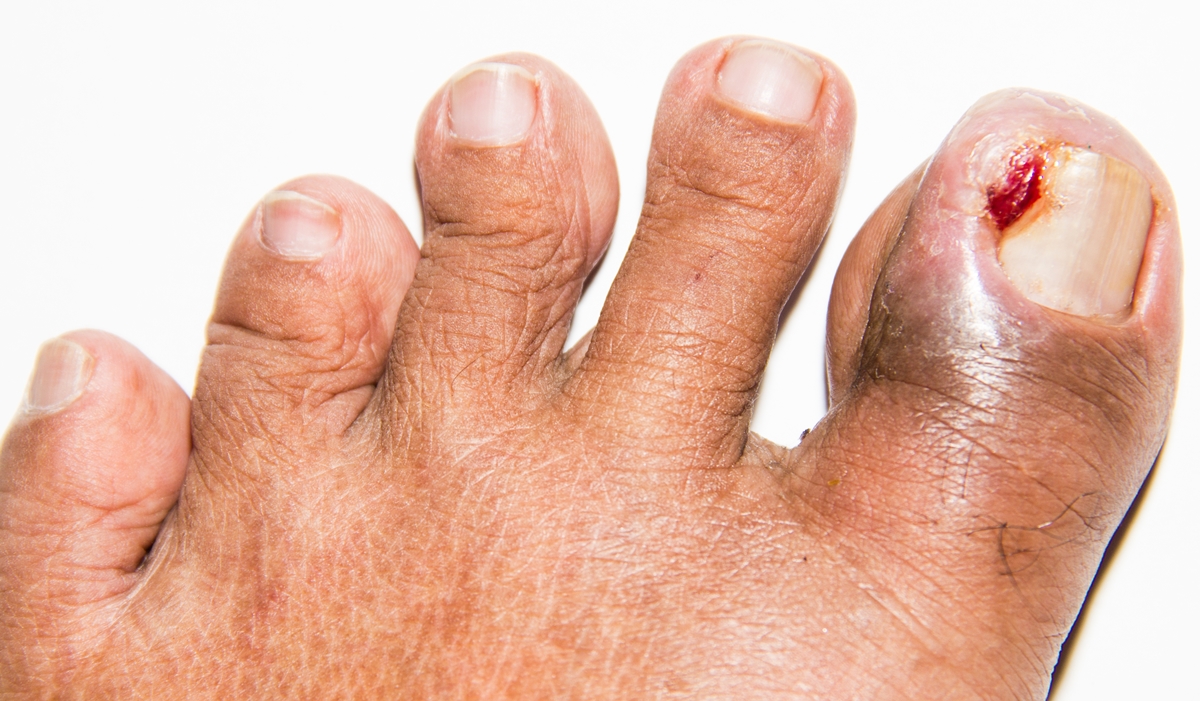
An ingrown toenail occurs when the edge of the nail grows down and into the skin of the toe.
Causes
An ingrown toenail can result from a number of things. Poorly fitting shoes and toenails that are not properly trimmed are the most common causes. The skin along the edge of a toenail may become red and infected. The great toe is affected most often, but any toenail can become ingrown. Ingrown toenails can also be a genetic.
An ingrown toenail may occur when extra pressure is placed on your toe. This pressure is caused by shoes that are too tight or too loose. If you walk often or participate in athletics, a shoe that is even a little tight can cause this problem. Deformities of the foot or toes can also place extra pressure on the toe.
Nails that are not trimmed properly can also cause ingrown toenails:
- Toenails that are trimmed too short, or if the edges are rounded rather than cut straight across may cause the nail to curl downward and grow into the skin.
- Poor eyesight, inability to reach the toes easily, or having thick nails can make it hard to properly trim nails.
- Picking or tearing at the corners of the nails can also cause an ingrown toenail.
Some people are born with nails that are curved and grow downward. Others have toenails that are too large for their toes. Stubbing your toe or other injuries can also lead to an ingrown toenail.
Symptoms
There may be pain, redness and swelling around the nail.
Exams and Tests
An exam of the foot will show the following:
- Skin along the edge of the nail appears to be growing over the nail, or the nail seems to be growing underneath the skin.
- Skin is swollen, firm, red, or tender to touch. There may be a small amount of pus.
Treatment
If you have diabetes, nerve damage in the leg or foot, poor blood circulation to your foot, or an infection around the nail, go to the doctor right away. Do not try to treat an ingrown nail at home.
If your ingrown nail does not heal or keeps coming back, your doctor may remove part of the nail:
If the toe is infected, your doctor may prescribe antibiotics.
Outlook (Prognosis)
Treatment usually controls the infection and relieves pain. The condition is likely to return if you do not practice good foot care.
This condition may become serious in people with diabetes, poor blood circulation, and nerve problems (peripheral neuropathies).
Possible Complications
In severe cases, the infection can spread through the toe and into the bone.
When to Contact a Medical Professional
Call your health care provider if you:
- Are unable to trim an ingrown toenail
- Have pain, redness, swelling, or fever
If you have diabetes, nerve damage in the leg or foot, poor blood circulation to your foot, or an infection around the nail, your risk for complications is higher. If you have diabetes, see your provider.
Prevention
Wear shoes that fit properly. Shoes that you wear every day should have plenty of room around your toes. Shoes that you wear for walking briskly or for running should also have plenty of room, but not be too loose.
When trimming your toenails:
- Briefly soak your foot in warm water to soften the nail.
- Use a clean, sharp nail trimmer.
- Trim toenails straight across the top. Do not taper or round the corners or trim too short.
- Do not pick or tear at the nails.
Keep your feet clean and dry. People with diabetes should have routine foot exams and nail care.